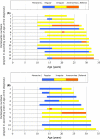Polycystic ovary syndrome: early diagnosis and intervention are necessary for fertility preservation in young women with endometrial cancer under 35 years of age
- PMID: 29259453
- PMCID: PMC5715875
- DOI: 10.1002/rmb2.12012
Polycystic ovary syndrome: early diagnosis and intervention are necessary for fertility preservation in young women with endometrial cancer under 35 years of age
Abstract
Aim: Polycystic ovary syndrome (PCOS) is a significant risk factor for premenopausal endometrial cancer (EC) and/or atypical endometrial hyperplasia (AEH). The aim was to elucidate the clinical background and detailed menstrual history of EC and/or AEH in young women with PCOS.
Methods: From January 2001 to December 2013, women under 35 years of age who had been diagnosed with EC and/or AEH and who had been treated at Kumamoto University Hospital, Japan, were recruited. The patients' clinical characteristics, clinical stages of EC and/or AEH, medication and operation methods, endocrine profiles, and menstrual history were assessed retrospectively.
Results: Of all the cases of EC and/or AEH, 25 (4.6%) were under 35 years of age. The mean age was 29.0 years and all the patients were nulligravida. The clinical stages of EC and/or AEH that were identified included: AEH (five cases), stage IA (18 cases), IB (one case), and IIIA (one case). Fourteen (56%) cases met the criteria for PCOS. Both the Body Mass Index and Homeostatic Model Assessment-insulin resistance were significantly higher in the patients with PCOS than in the patients without PCOS. Medroxyprogesterone acetate therapy was not effective for the patients with PCOS and they underwent a hysterectomy more often than the patients without PCOS. All the patients with PCOS exhibited irregular menstruation or amenorrhea, the mean duration of which was 13.1 years before PCOS and EC and/or AEH were diagnosed.
Conclusion: Although both the patients with and without PCOS had irregular menstruation, the patients with PCOS were less likely to have fertility-sparing surgery than the patients without PCOS because they had more advanced disease or failed to respond to medroxyprogesterone acetate therapy.
Keywords: atypical endometrial hyperplasia; endometrial cancer; insulin resistance; organ‐sparing treatments; polycystic ovary syndrome.
Figures

References
-
- Azziz R, Woods KS, Reyna R, Key TJ, Knochenhauer ES, Yildiz BO. The prevalence and feature of the polycystic ovary syndrome in an unselected population. J Clin Endocrinol Metab. 2004;89:2745–2749. - PubMed
-
- The Rotterdam ESHRE/ASRM‐Sponsored PCOS Consensus Workshop Group . Revised 2003 consensus on diagnostic criteria and long‐term health risks related to polycystic ovarian syndrome (PCOS). Fertil Steril. 2004;81:19–25. - PubMed
-
- Azziz R, Carmina E, Dewailly D, et al.; Task Force on the Phenotype of the Polycystic Ovary Syndrome of The Androgen Excess and PCOS Society . The Androgen Excess and PCOS Society criteria for the polycystic ovary syndrome: the complete task force report. Fertil Steril. 2009;91:456–488. - PubMed
-
- Dokras A, Bochner M, Hollinrake E, Markham S, Vanvoorhis B, Jagasia DH. Screening women with polycystic ovary syndrome for metabolic syndrome. Obstet Gynecol. 2005;106:131–137. - PubMed
LinkOut - more resources
Full Text Sources
Other Literature Sources
Miscellaneous
